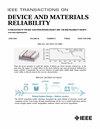Solution-Processed In₂O₃ Doped 2-D MoS₂ Thin-Film Transistors With Improvement of Electrical Properties by UV/Ozone Treatment
IF 2.3
3区 工程技术
Q2 ENGINEERING, ELECTRICAL & ELECTRONIC
IEEE Transactions on Device and Materials Reliability
Pub Date : 2025-06-30
DOI:10.1109/TDMR.2025.3581148
引用次数: 0
Abstract
In this paper, channel layer films of indium oxide (In2O3) solution doped with molybdenum disulfide (MoS2) were prepared at low temperature (250°C). Then the electrical properties of thin-film transistors (TFTs) devices were investigated using ultraviolet/ozone (UV/Ozone) treatment process. The results show that the selection of the appropriate time for the UV/Ozone treatment process can effectively improve the electrical properties of In2O3-MoS2 TFTs devices, leading to the preparation of reliable electronic devices at low temperatures. Specifically, the 40 s UV/Ozone treatment TFTs have relatively high saturation mobility of用UV/臭氧处理溶液处理In₂O₃掺杂2-D MoS₂薄膜晶体管并改善其电性能
本文在低温(250℃)条件下制备了掺杂二硫化钼(MoS2)的氧化铟(In2O3)溶液的沟道层薄膜。然后采用紫外/臭氧(UV/ ozone)处理工艺研究了薄膜晶体管(TFTs)器件的电学性能。结果表明,选择合适的时间进行UV/Ozone处理工艺,可以有效改善In2O3-MoS2 TFTs器件的电学性能,从而在低温下制备出可靠的电子器件。具体而言,40 s UV/臭氧处理TFTs具有较高的饱和迁移率$2.08~\pm ~0.02$ cm2V ${}^{-}1 $ $ $ ${}^{-}1 $ $ $和开关电流比$3.09\ × 10{^{{6}}}$,以及相对较低的阈值电压和亚阈值振荡值$3.74~\pm ~0.03$ V和$0.61~\pm ~0.01$ V,并且在暴露于环境空气30天后电学性能稳定。与未经该工艺处理的设备相比,UV/臭氧处理产生了稳定的电气特性,这在电子应用中具有潜力,预计将广泛用于各种新兴电子设备的半导体。
本文章由计算机程序翻译,如有差异,请以英文原文为准。
求助全文
约1分钟内获得全文
求助全文
来源期刊

IEEE Transactions on Device and Materials Reliability
工程技术-工程:电子与电气
CiteScore
4.80
自引率
5.00%
发文量
71
审稿时长
6-12 weeks
期刊介绍:
The scope of the publication includes, but is not limited to Reliability of: Devices, Materials, Processes, Interfaces, Integrated Microsystems (including MEMS & Sensors), Transistors, Technology (CMOS, BiCMOS, etc.), Integrated Circuits (IC, SSI, MSI, LSI, ULSI, ELSI, etc.), Thin Film Transistor Applications. The measurement and understanding of the reliability of such entities at each phase, from the concept stage through research and development and into manufacturing scale-up, provides the overall database on the reliability of the devices, materials, processes, package and other necessities for the successful introduction of a product to market. This reliability database is the foundation for a quality product, which meets customer expectation. A product so developed has high reliability. High quality will be achieved because product weaknesses will have been found (root cause analysis) and designed out of the final product. This process of ever increasing reliability and quality will result in a superior product. In the end, reliability and quality are not one thing; but in a sense everything, which can be or has to be done to guarantee that the product successfully performs in the field under customer conditions. Our goal is to capture these advances. An additional objective is to focus cross fertilized communication in the state of the art of reliability of electronic materials and devices and provide fundamental understanding of basic phenomena that affect reliability. In addition, the publication is a forum for interdisciplinary studies on reliability. An overall goal is to provide leading edge/state of the art information, which is critically relevant to the creation of reliable products.
 求助内容:
求助内容: 应助结果提醒方式:
应助结果提醒方式:


